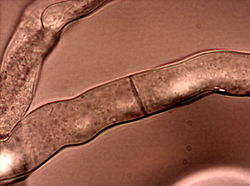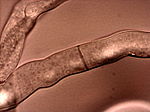Neurospora crassa
| Den här artikeln har skapats av Lsjbot, ett program (en robot) för automatisk redigering. (2012-10) Artikeln kan innehålla fakta- eller språkfel, eller ett märkligt urval av fakta, källor eller bilder. Mallen kan avlägsnas efter en kontroll av innehållet (vidare information) |
| Neurospora crassa | |
 | |
| Systematik | |
|---|---|
| Domän | Eukaryoter Eukaryota |
| Rike | Svampar Fungi |
| Division | Sporsäcksvampar Ascomycota |
| Klass | Sordariomycetes |
| Ordning | Sordariales |
| Familj | Sordariaceae |
| Släkte | Neurospora |
| Art | Neurospora crassa |
| Vetenskapligt namn | |
| § Neurospora crassa | |
| Auktor | Shear & B.O. Dodge 1927 |
Neurospora crassa är en svampart[1] som beskrevs av Shear & B.O. Dodge 1927. Neurospora crassa ingår i släktet Neurospora och familjen Sordariaceae.[2][3] Inga underarter finns listade i Catalogue of Life.[2]
Källor
- ^ Shear & B.O. Dodge (1927) , In: J. Agric. Res., Washington 34:1062
- ^ [a b] Bisby F.A., Roskov Y.R., Orrell T.M., Nicolson D., Paglinawan L.E., Bailly N., Kirk P.M., Bourgoin T., Baillargeon G., Ouvrard D. (red.) (2 september 2011). ”Species 2000 & ITIS Catalogue of Life: 2011 Annual Checklist.”. Species 2000: Reading, UK. http://www.catalogueoflife.org/annual-checklist/2011/search/all/key/neurospora+crassa/match/1. Läst 24 september 2012.
- ^ Species Fungorum. Kirk P.M., 2010-11-23
 Wikimedia Commons har media som rör Neurospora crassa.
Wikimedia Commons har media som rör Neurospora crassa.
Bildgalleri
Media som används på denna webbplats
Robot icon
Författare/Upphovsman: Roland Gromes, Licens: CC BY-SA 3.0
Hyphae of Neurospora crassa with septum and porus
Författare/Upphovsman: Chaya5260, Licens: CC BY-SA 3.0
Neurospora crassa life cycle. The haploid mycelium reproduces asexually by two processes: (1) simple proliferation of existing mycelium, and (2) formation of conidia (macro- and micro-) which can be dispersed and then germinate to produce new mycelium. In the sexual cycle, mating can only occur between individual strains of different mating type, A and a. Fertilization occurs by the passage of nuclei of conidia or mycelium of one mating type into the protoperithecia of the opposite mating type through the trichogyne. Fusion of the nuclei of opposite mating types occurs within the protoperithecium to form a zygote (2N) nucleus.



